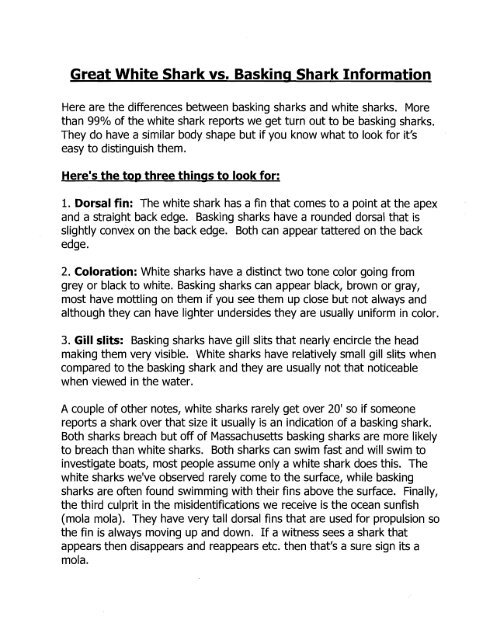Great White Shark vs. Basking Shark Infomation - Town Of Orleans
Great White Shark vs. Basking Shark Infomation - Town Of Orleans
Great White Shark vs. Basking Shark Infomation - Town Of Orleans
- No tags were found...
You also want an ePaper? Increase the reach of your titles
YUMPU automatically turns print PDFs into web optimized ePapers that Google loves.
<strong>Great</strong> <strong>White</strong> <strong>Shark</strong> <strong>vs</strong>. <strong>Basking</strong> <strong>Shark</strong> Information<br />
Here are the differences between basking sharks and white sharks. More<br />
than 99% of the white shark reports we get turn out to be basking sharks.<br />
They do have a similar body shape but if you know what to look for it's<br />
easy to distinguish them.<br />
Here's the top three things to look for:<br />
1. Dorsal fin: The white shark has a fin that comes to a point at the apex<br />
and a straight back edge. <strong>Basking</strong> sharks have a rounded dorsal that is<br />
slightly convex on the back edge. Both can appear tattered on the back<br />
edge.<br />
2. Coloration: <strong>White</strong> sharks have a distinct two tone color going from<br />
grey or black to white. <strong>Basking</strong> sharks can appear black, brown or gray,<br />
most have mottling on them if you see them up close but not always and<br />
although they can have lighter undersides they are usually uniform in color.<br />
3. Gill slits: <strong>Basking</strong> sharks have gill slits that nearly encircle the head<br />
making them very visible. <strong>White</strong> sharks have relatively small gill slits when<br />
compared to the basking shark and they are usually not that noticeable<br />
when viewed in the water.<br />
A couple of other notes, white sharks rarely get over 20' so if someone<br />
reports a shark over that size it usually is an indication of a basking shark.<br />
Both sharks breach but off of Massachusetts basking sharks are more likely<br />
to breach than white sharks. Both sharks can swim fast and will swim to<br />
investigate boats, most people assume only a white shark does this. The<br />
white sharks we've observed rarely come to the surface, while basking<br />
sharks are often found swimming with their fins above the surface. Finally,<br />
the third culprit in the misidentifications we receive is the ocean sunfish<br />
(mola mola). They have very tall dorsal fins that are used for propulsion so<br />
the fin is always moving up and down. If a witness sees a shark that<br />
appears then disappears and reappears etc. then that's a sure sign its a<br />
mola.
•<br />
•
















